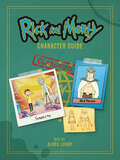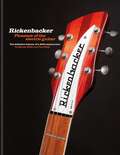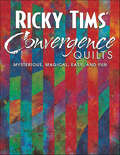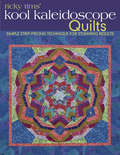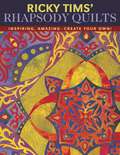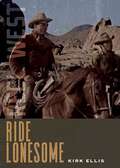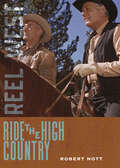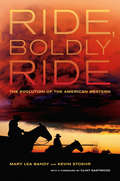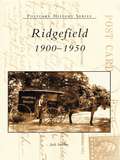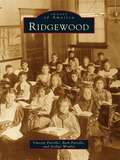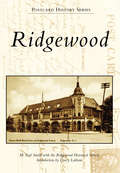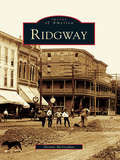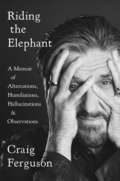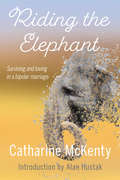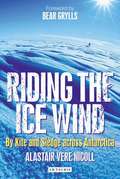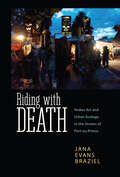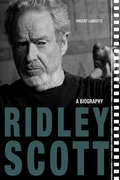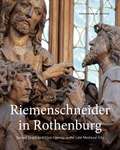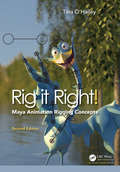- Table View
- List View
Rick and Morty Character Guide
by Albro LundyAn oversized full-color hardcover encyclopedia collecting hilarious trivia on the characters from the ultra-hit animated series!In an interdimensional reality as crazy and wild as Rick and Morty, it can be hard to keep all of the characters straight, and now you don't have to use any more of your precious brain space to do it! It's all in this here book, baby!In this new collection, learn all about your favorite (and not so favorite) characters from around the multiverse. Take a look at all of the titular characters, the humans and the aliens, with the Rick and Morty Character Guide. Want to know more about the Council of Ricks? Or Ricks feelings on Zeep Xanflorp? Or why Bird Person talks like that? This book has got you covered!Collecting information on the whole cast of characters, this book is a must-have for any fan of the award-winning Adult Swim show!
Rickenbacker Guitars: The definitive history of a 20th-century icon
by Martin Kelly Paul KellyA STUNNING NEW AND COMPLETELY REVISED EDITION OF THE RICKENBACKER BIBLE FOR 2023'Knowing Martin and Paul Kelly's perfectionism and attention to detail it's no surprise that this is the ultimate and complete story of all things Rickenbacker.' - Johnny Marr'A wonderful history of my favourite guitar. The attention to detail is amazing!' - Roger McGuinn'There are few things more satisfying than the shimmer of an open chord played on a Rickenbacker through a Fender Deluxe Reverb amplifier. Martin and Paul have given us the definitive history of these magical instruments.' - Susanna HoffsRickenbacker Guitars is the highly anticipated follow up to Fender: The Golden Age, charting the story of one of the most important and influential guitar makers of all time. From George Beauchamp's invention of the world's first commercially viable electric guitar in 1931, through the company's heyday during the 1960s - when their instruments were favoured by The Beatles, The Byrds and The Who - and up to the continuing legacy of Rickenbacker today.This definitive collection features unprecedented access to the company archives, 350 beautifully photographed original instruments - including all 7 surviving Beatles owned Rickenbackers - and new interviews with legendary Rickenbacker players such as Roger McGuinn, Peter Buck, Susanna Hoffs, Johnny Marr, Mike Campbell, Geddy Lee and Paul Weller.Rickenbacker Guitars is the most comprehensive history of the brand to date and a must-have for all guitar enthusiasts.
Rickenbacker Guitars: The definitive history of a 20th-century icon
by Martin Kelly Paul KellyA STUNNING NEW AND COMPLETELY REVISED EDITION OF THE RICKENBACKER BIBLE FOR 2023'Knowing Martin and Paul Kelly's perfectionism and attention to detail it's no surprise that this is the ultimate and complete story of all things Rickenbacker.' - Johnny Marr'A wonderful history of my favourite guitar. The attention to detail is amazing!' - Roger McGuinn'There are few things more satisfying than the shimmer of an open chord played on a Rickenbacker through a Fender Deluxe Reverb amplifier. Martin and Paul have given us the definitive history of these magical instruments.' - Susanna HoffsRickenbacker Guitars is the highly anticipated follow up to Fender: The Golden Age, charting the story of one of the most important and influential guitar makers of all time. From George Beauchamp's invention of the world's first commercially viable electric guitar in 1931, through the company's heyday during the 1960s - when their instruments were favoured by The Beatles, The Byrds and The Who - and up to the continuing legacy of Rickenbacker today.This definitive collection features unprecedented access to the company archives, 350 beautifully photographed original instruments - including all 7 surviving Beatles owned Rickenbackers - and new interviews with legendary Rickenbacker players such as Roger McGuinn, Peter Buck, Susanna Hoffs, Johnny Marr, Mike Campbell, Geddy Lee and Paul Weller.Rickenbacker Guitars is the most comprehensive history of the brand to date and a must-have for all guitar enthusiasts.
Ricky Tims Convergence Quilts: Mysterious, Magical, Easy, and Fun
by Ricky TimsBecome a fabulous quilt artist - the fun, easy way! Popular quilting expert Ricky Tims presents an imaginative, new piecing technique that quilters will adore! Convergence quilts feature two or more fabrics cut into strips, sewn together, then cut and pieced again. Nothing could be simpler - or more magical! Ricky offers lots of creative guidelines but no hard-and-fast rules, so every Convergence quilt is a unique work of art. • 4 projects walk you through the steps of making Convergence quilts • Quilts look complex but are fun, easy, and, best of all, creative to make • Use any fabric from commercial prints to hand-dyed • Add decorative touches such as appliqué to dress up your projects • An infinite number of looks from one ingenious technique
Ricky Tims' Kool Kaleidoscope Quilts: Simple Strip-Piecing Technique for Stunning Results
by Ricky TimsLearn Tims’ innovative techniques step-by-step to create a stunning kaleidoscope quilt of your own.• An inspirational gallery of 26 student quilts• Like snowflakes, each quilt you make with this technique will be unique• Includes easy steps to enlarge or reduce the size of your quiltCreate a spectacular kaleidoscope quilt with Ricky's unique strip-piecing method for making a multi-faceted pattern. You'll see impressive and intricate results from simple sets of strips; it’s foolproof with little need for pre-planning. The beauty lies in the unpredictability of how the fabric unfolds—just like a real kaleidoscope!
Ricky Tims' Rhapsody Quilts: Inspiring, Amazing—Create Your Own!
by Ricky TimsMake One-of-a-Kind Contemporary Quilts With a Traditional Flair - Ricky Tims Shows You How! • Learn to design, choose fabrics, and make templates for these one-of-a-kind beauties • Handle curves easily with Ricky's sure-fire method for No-Pin Precision Curved Piecing • Start with 5 ready-made design outlines, then expand the possibilities by composing your own Rhapsody quilts • Learn Ricky's secrets for enhancing your designs with appliqué • Get inspired by the gallery of Rhapsody quilts made by Ricky and other quilters just like you! Rhapsody Quilts are medallion-style quilts with graceful, curved designs in a reversed and mirrored arrangement. Like a musical rhapsody, the form is flexible and lets you express an endless variety of themes and motifs. Ricky shows you how to work with your quilt's basic “skeleton,” then enhance your design themes with original appliqué or lush quilting. You'll take away all the techniques you need to start making your own beautiful quilt rhapsodies. Visit C&T Publishing's YouTube channel to view the video trailer!
Ride Lonesome (Reel West Series)
by Kirk EllisRide Lonesome, the fifth film in the &“Ranown cycle,&” is both the best and most representative of the whole cycle, which has been called &“the most remarkable convergence of artistic achievement in the history of low-budget moviemaking.&” Director Bud Boetticher captures the alienation and loneliness of an America faced with the Cold War and the daily threat of nuclear annihilation. Shot in seventeen days for under a half-million dollars, Ride Lonesome is a masterpiece of cinematic minimalism.Veteran screenwriter Kirk Ellis brilliantly unpacks the themes, narrative, visual language, and editing in this seminal film. In Ride Lonesome he not only shows how this one film embodies a turning point for the Western, but he also explores the unique vision and contributions of director Boetticher and his writing partner Burt Kennedy.
Ride the High Country (Reel West Series)
by Robert NottDirector Sam Peckinpah was just starting out when MGM released Ride the High Country in 1962. He was a new kind of director: young, brash, and in a hurry to help the Western grow up by treating it with adult themes. Ride the High Country was something new and different, a changing Western to match a changing West. Stars Randolph Scott and Joel McCrea were old hands at this sort of thing. Ride the High Country gave the two veteran actors one last job to do and a chance to go out with some dignity.Ride the High Country helped the genre mature and adapt to turbulent, changing times. It launched Peckinpah's career by invoking the themes of honor, loyalty, and compromised ideals, the destruction of the West and its heroes, and the difficulty of doing right in an unjust world--themes developed to their pinnacle in Peckinpah's later masterpiece, The Wild Bunch.
Ride, Boldly Ride: The Evolution of the American Western
by Mary Lea Bandy Kevin StoehrThis comprehensive study of the Western covers its history from the early silent era to recent spins on the genre in films such as No Country for Old Men, There Will Be Blood, True Grit, and Cowboys & Aliens. While providing fresh perspectives on landmarks such as Stagecoach, Red River, The Searchers, The Man Who Shot Liberty Valance, and The Wild Bunch, the authors also pay tribute to many under-appreciated Westerns. Ride, Boldly Ride explores major phases of the Western's development, including silent era oaters, A-production classics of the 1930s and early 1940s, and the more psychologically complex portrayals of the Westerner that emerged after World War II. The authors also examine various forms of genre-revival and genre-revisionism that have recurred over the past half-century, culminating especially in the masterworks of Clint Eastwood. They consider themes such as the inner life of the Western hero, the importance of the natural landscape, the roles played by women, the tension between myth and history, the depiction of the Native American, and the juxtaposing of comedy and tragedy. Written in clear, engaging prose, this is the only survey that encompasses the entire history of this long-lived and much-loved genre.
Ridgefield (Images of America)
by Mauro De SantisIn 1662, two men and their families settled along the banks of Overpeck Creek. At this location, the township of Ridgefield would be established and later become the beloved borough of Ridgefield. Historically, the settlement of Ridgefield began as a modest subdivision within the English Neighborhood that spanned an area of 10 square miles, centrally located between the Hudson River and Hackensack River. This valley, with its unique location and close proximity to New York City, intrigued many people. This caused substantial real estate growth, creating a community that would forever be adored by many. Ridgefield was home to distinguished residents, such as Samuel F.B. Morse, inventor of the Morse code, and Alexander Shaler, Civil War Union army general and Medal of Honor recipient. The charming landscape and stunning views would captivate some of America�s most prominent 20th-century artists. This collection of historical images provides a glimpse into what Ridgefield once was and how it grew into what it is today.
Ridgefield: 1900-1950
by Jack SandersRidgefield has long been a destination-for tourists seeking a picturesque country village, for city dwellers looking for a weekend and summer retreat, and for immigrants in search of a new life. In the first half of the twentieth century, a period that corresponded to the heyday of the picture postcard, hundreds of views were published, depicting the beautiful Main Street, the many inns and resorts, the mansions, estates, village shops, churches, and scenic hills and lakes. Ridgefield: 1900-1950 offers more than two hundred of these glimpses of a bygone time of affluence and change-what one historian has called Ridgefield's golden era.
Ridgewood
by Arthur Wrubel Vincent Parrillo Beth ParrilloRidgewood, New Jersey, might still be known as Godwinville had it not been for the efforts of Cornelia Dayton, the wife of a real estate developer, who continually lobbied for the name change until the post office recognized it in 1865. By 1876, the community received township status. Street scenes portray Ridgewood's evolution from dirt to cobblestone to asphalt-paved roads, and the changefrom a railroad grade crossing at Ridgewood Avenue to an underpass at Franklin Avenue. Sections on the historic buildings and homes are arranged so one can take a tour from one to the next, aided by in-text maps. Other sections depict the nineteenth-century mansions, community life of bygone eras, and the "lost" buildings due to fire or "progress."
Ridgewood (Postcard History Series)
by M. Earl Smith The Ridgewood Historical Society Dacey LathamGiven that Ridgewood lies within 20 miles of Lower Manhattan, it would be easy to dismiss this little town as another New York suburb. Settled by Johannes Van Emburgh in 1700, this slice of New Jersey was a pivotal safe haven for the founding fathers, such as George Washington, Alexander Hamilton, and Aaron Burr. In 1894, the State of New Jersey incorporated the area as a village, and what followed were 100 years of business and leisure with places like Woolworth�s, the Erie Railroad Company, and First National Bank dominating the landscape. Today, Ridgewood serves as a home for those who wish to evade the city life of the boroughs. With its distinct mix of history and comfort, Ridgewood is unique in comparison to other towns in New Jersey and a fine place to call home.
Ridgway
by Dennis McgeehanRidgway, known as the "lily of the valley," is located on the scenic Clarion River in Pennsylvania's Allegheny Mountains. Ridgway's history has long been closely linked to the river, from a time when residents utilized the water to float timber from the nearby forested hills and supplied lumber for operations around the nation. Much of the beautiful hardwood craftsmanship is preserved today and on display in the elegant Victorian mansions of Ridgway's former lumber barons. The county seat of Elk County, Ridgway has never let the decline of the lumber industry affect its vitality, and today it is a peaceful, artistic community that draws tourists with its idyllic location. Through historic photographs, Ridgway chronicles the history of this progressive community that remains committed to preserving its past, as well as its future.
Riding Shotgun with Norman Wallace: Rephotographing the Arizona Landscape
by William WyckoffIn Riding Shotgun with Norman Wallace, award-winning geographer William Wyckoff celebrates the photographic legacy of Norman Grant Wallace, whose work as an Arizona highway engineer during the first half of the twentieth century afforded him the opportunity to survey every corner of the Grand Canyon State. Possessing a passion for photography, Wallace documented Arizona throughout his travels. From 1906 to 1969 Wallace photographed the state&’s natural and rural landscapes; its burgeoning infrastructure including roads, bridges, and dams; and its towns and cities, some of which experienced exponential growth following World War II.Nearly one hundred years later, Wyckoff retraces Wallace&’s southwestern travels using the engineer&’s photographs and meticulous notebooks as a guide. The author rephotographs many of Wallace&’s iconic vantage points, giving us a historical tour of Arizona, a &“then-and-now&” viewpoint that also tells the personal story of Wyckoff&’s own vicarious travels with Wallace through Arizona&’s vast countryside and its urban centers and small towns.
Riding the Elephant: A Memoir of Altercations, Humiliations, Hallucinations, and Observations
by Craig FergusonFrom the comedian, actor, and former host of The Late Late Show comes an irreverent, lyrical memoir in essays featuring his signature wit. Craig Ferguson has defied the odds his entire life. He has failed when he should have succeeded and succeeded when he should have failed. The fact that he is neither dead nor in a locked facility (at the time of printing) is something of a miracle in itself. In Craig’s candid and revealing memoir, readers will get a look into the mind and recollections of the unique and twisted Scottish American who became a national hero for pioneering the world’s first TV robot skeleton sidekick and reviving two dudes in a horse suit dancing as a form of entertainment. In Riding the Elephant, there are some stories that are too graphic for television, too politically incorrect for social media, or too meditative for a stand-up comedy performance. Craig discusses his deep love for his native Scotland, examines his profound psychic change brought on by fatherhood, and looks at aging and mortality with a perspective that he was incapable of as a younger man. Each story is strung together in a colorful tapestry that ultimately reveals a complicated man who has learned to process—and even enjoy—the unusual trajectory of his life.
Riding the Elephant: Surviving and loving in a bipolar marriage
by Catharine McKentyHost of Montreal’s top-rated English radio talk show, Neil McKenty appeared rational, balanced and a calming influence in any crisis. Would anyone have believed that this sparkling public figure was very different behind closed doors?They met on the dance floor: he, a former Jesuit; she, grand-daughter of a two-time mayor of Toronto. Raised by her single mother, Catharine left the staid life of tea-parties for reconciliation work in post-war Europe. As a journalist for Pace, a magazine for adventurous youth of the 1960s, she conquered Los Angeles from the wheel of a pink Jaguar, unearthing a scoop that resulted in a best-selling book and Hollywood movie.Friends applauded that Catharine had found her intellectual equal. When her new husband’s outbursts began, she attributed it to the stresses of married life. People knew little about mental illness in those days. It was far too uncomfortable to talk about. The word bipolar was virtually unknown.Together the McKentys wrote two best-selling books, rubbed shoulders with prime ministers, and worked closely with spiritual elites. Sandwiched between the couple’s many accomplishments were Neil’s suicidal depression and Catharine’s desperate attempts to cope.Catharine examines the influences that helped her to maintain her sanity and the sanctity of marriage with a talented and troubled husband. She aims to empower others who care deeply about someone affected with bipolar disorder.
Riding the Ice Wind: By Kite and Sledge Across Antarctica
by Alastair Vere NicollAlastair Vere Nicoll joined a team of young men to harness the katabatic winds and kite-surf across Antarctica. This is the story of the first West-to-East traverse of Antarctica and of the crossing of two phases in the author's life from youth into manhood, fantasy into reality.
Riding with Death: Vodou Art and Urban Ecology in the Streets of Port-au-Prince (Caribbean Studies Series)
by Jana Evans BrazielOn the southern end of the Grand Rue, a major thoroughfare that runs through the center of Port-au-Prince, waits the Haitian capital's automobile repair district. This veritable junkyard of steel and rubber, recycled parts, old tires, and scrap metal might seem an unlikely foundry for art. Yet, on the street's opposite end thrives the Grand Rue Galerie, a working studio of assembled art and sculptures wrought from the refuse.Established by artists André Eugène and Jean Hérard Celeur in the late 1990s, the Grand Rue's urban environmental aesthetics--defined by motifs of machinic urbanism, Vodou bricolage, the postprimitivist altermodern, and performative politics--radically challenge ideas about consumption, waste, and environmental hazards, as well as consider innovative solutions to these problems in the midst of poverty, insufficient social welfare, lack of access to arts, education, and basic needs.In Riding with Death, Jana Evans Braziel explores the urban environmental aesthetics of the Grand Rue sculptors and the beautifully constructed sculptures they have designed from salvaged automobile parts, rubber tires, carved wood, and other recycled materials. Through first-person accounts and fieldwork, Braziel constructs an urban ecological framework for understanding these sculptures amid environmental degradation and grinding poverty. Above all, Braziel presents Haitian artists who live on the most challenged Caribbean island, yet who thrive as creators reinventing refuse as art and resisting the abjection of their circumstances.
Riding, Roping, and Bulldogging - Almost
by Gary PaulsenA humorous commentary of various aspects of professional rodeo competition, for children.
Ridley Scott: A Biography (Screen Classics)
by Vincent LoBruttoA study of the iconic and influential film director’s life and work, from the author of Stanley Kubrick: A Biography.With celebrated works such as Alien, Blade Runner, Thelma & Louise, and Gladiator, Ridley Scott has secured his place in Hollywood. This legendary director and filmmaker has had an undeniable influence on art and the culture of filmmaking, but is also a respected media businessman.In Ridley Scott: A Biography, Vincent LoBrutto delves into Ridley Scott’s oeuvre in a way that allows readers to understand the yin and yang of his exceptional career, offering a unique crosscut between the biographical facts of Scott’s personal life—his birth and early days in northeast England, his life in New York City—and his career in Hollywood as a director and producer of television commercials, TV series, miniseries, and feature films.Every film is presented, analyzed, and probed for a greater understanding of the visionary, his personality, and his thought process, for a deeper perception of his astounding work and accomplishments. The voices of cast and crew who have worked with Ridley Scott, as well as the words of the man himself, are woven throughout this book for a fully realized, critical biography, revealing the depth of the artist and his achievements.
Riemenschneider in Rothenburg: Sacred Space and Civic Identity in the Late Medieval City
by Katherine M. BoivinThe concept of the medieval city is fixed in the modern imagination, conjuring visions of fortified walls, towering churches, and winding streets. In Riemenschneider in Rothenburg, Katherine M. Boivin investigates how medieval urban planning and artistic programming worked together to form dynamic environments, demonstrating the agency of objects, styles, and spaces in mapping the late medieval city.Using altarpieces by the famed medieval artist Tilman Riemenschneider as touchstones for her argument, Boivin explores how artwork in Germany’s preeminent medieval city, Rothenburg ob der Tauber, deliberately propagated civic ideals. She argues that the numerous artistic pieces commissioned by the city’s elected council over the course of two centuries built upon one another, creating a cohesive structural network that attracted religious pilgrims and furthered the theological ideals of the parish church. By contextualizing some of Rothenburg’s most significant architectural and artistic works, such as St. James’s Church and Riemenschneider’s Altarpiece of the Holy Blood, Boivin shows how the city government employed these works to establish a local aesthetic that awed visitors, raising Rothenburg’s profile and putting it on the pilgrimage map of Europe.Carefully documented and convincingly argued, this book sheds important new light on the history of one of Germany’s major tourist destinations. It will be of considerable interest to medieval art historians and scholars working in the fields of cultural and urban history.
Riemenschneider in Rothenburg: Sacred Space and Civic Identity in the Late Medieval City
by Katherine M. BoivinThe concept of the medieval city is fixed in the modern imagination, conjuring visions of fortified walls, towering churches, and winding streets. In Riemenschneider in Rothenburg, Katherine M. Boivin investigates how medieval urban planning and artistic programming worked together to form dynamic environments, demonstrating the agency of objects, styles, and spaces in mapping the late medieval city.Using altarpieces by the famed medieval artist Tilman Riemenschneider as touchstones for her argument, Boivin explores how artwork in Germany’s preeminent medieval city, Rothenburg ob der Tauber, deliberately propagated civic ideals. She argues that the numerous artistic pieces commissioned by the city’s elected council over the course of two centuries built upon one another, creating a cohesive structural network that attracted religious pilgrims and furthered the theological ideals of the parish church. By contextualizing some of Rothenburg’s most significant architectural and artistic works, such as St. James’s Church and Riemenschneider’s Altarpiece of the Holy Blood, Boivin shows how the city government employed these works to establish a local aesthetic that awed visitors, raising Rothenburg’s profile and putting it on the pilgrimage map of Europe.Carefully documented and convincingly argued, this book sheds important new light on the history of one of Germany’s major tourist destinations. It will be of considerable interest to medieval art historians and scholars working in the fields of cultural and urban history.
RifleShooter Magazine's Guide to Big-Game Hunting
by Editors of RifleShooter J. Scott RuppFor the first time in a book, RifleShooter's top experts share their thoughts on rifles, calibers, optics, and more for hunting big game in North America and beyond. RifleShooter Magazine's Guide to Big-Game Hunting is packed with useful information specifically geared toward big game hunting with rifles. A vast range of topics are covered in these articles, including:Light rifle accuracy Weatherproofing your rifle Caliber pros and cons Modern scopes Going lead-free Custom vs. factory rifles And much more! Discover tried and true tips, tactics, and techniques from the pros along with advice on buying gear and firearms from experts including Craig Boddington, Brad Fitzpatrick, Layne Simpson, and J. Scott Rupp. RifleShooter Magazine's Guide to Big-Game Hunting covers everything you need to know about effectively hunting big game with rifles.
Rig it Right! Maya Animation Rigging Concepts, 2nd edition
by Tina O'HaileyRig it Right! breaks down rigging so that you can achieve a fundamental understanding of the concept. The author will get you up and rigging with step-by-step tutorials covering multiple animation control types, connection methods, interactive skinning, BlendShapes, edgeloops, and joint placement, to name a few. The concept of a bi-ped is explored as a human compared to a bird character allowing you to see that a bi-ped is a bi-ped and how to problem solve for the limbs at hand. Rig it Right! will take you to a more advanced level where you will learn how to create stretchy rigs with invisible control systems and use that to create your own types of rigs. <P><P>Key Features <li>Hone your skills every step of the way with short tutorials and editable rigs that accompany each chapter. (17+ rigs!!). <li>Read "Tina’s 10 Rules of Rigging" and build the foundational knowledge needed to successfully rig your characters. <li>Visit the companion website and expand your newfound knowledge with editable rigs, exercises, and videos that elaborate on techniques covered in the book. <li>Companion data filled with example files at http://routledgetextbooks.com/textbooks/_author/ohailey/ <li>AR(Augmented Reality) enabled images throughout the book! <li>Coffee is not required – but encouraged.
